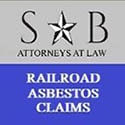
Asbestos exposure has been linked with many life threatening illnesses. This includes mesothelioma, lung cancer, throat cancer, esophageal cancer, stomach cancer, and colon cancer. These cancers may take as long as four decades to develop after exposure to asbestos. This is why it is important to stay on top of routine medical screenings to catch the earliest warning signs of developing asbestos related diseases.
If you or someone you love has developed cancer after working in an environment with asbestos, our attorneys want to help you. There is currently over $30 billion dollars put away in asbestos trust funds for individuals who develop health problems after being exposed to asbestos.
Our attorneys make it simple for you to file claims for these trusts and get awarded the financial compensation you deserve. If a member of your family has passed away from one of these illnesses, reach out to our team to learn more about your options and to determine if you are eligible to file an asbestos or mesothelioma claim.
We see our clients on a contingency basis, meaning that we only accept payment if we are able to recover compensation in your case. You have nothing to lose when you reach out to our team to discuss your asbestos case.
What factors affect the risk of developing an asbestos-related disease?
Several factors can help to determine how asbestos exposure affects an individual, including:
- Dose (how much asbestos an individual was exposed to)
- Duration (how long an individual was exposed)
- Size, shape, and chemical makeup of the asbestos fibers
- Source of the exposure
- Individual risk factors, such as smoking and pre-existing lung disease
- Genetic factors, such as having a germline mutation in BAP1
Although all forms of asbestos are considered hazardous, different types of asbestos fibers may be associated with different health risks. For example, the results of several studies suggest that amphibole forms of asbestos may be more harmful than chrysotile, particularly for mesothelioma risk, because they tend to stay in the lungs for a longer period of time.
How does smoking affect risk?
Many studies have shown that the combination of smoking and asbestos exposure is particularly hazardous. Smokers who are also exposed to asbestos have a risk of developing lung cancer that is greater than the individual risks from asbestos and smoking added together. There is evidence that quitting smoking will reduce the risk of lung cancer among asbestos-exposed workers. Smoking combined with asbestos exposure does not appear to increase the risk of mesothelioma. However, people who were exposed to asbestos on the job at any time during their life or who suspect they may have been exposed should not smoke.
How are asbestos-related diseases detected?
Individuals who have been exposed (or suspect they have been exposed) to asbestos fibers on the job, through the environment, or at home via a family contact should inform their doctor about their exposure history and whether or not they experience any symptoms. The symptoms of asbestos-related diseases may not become apparent for many decades after the exposure. It is particularly important to check with a doctor if any of the following symptoms develop:
- Shortness of breath, wheezing, or hoarseness
- A persistent cough that gets worse over time
- Blood in the sputum (fluid) coughed up from the lungs
- Pain or tightening in the chest
- Difficulty swallowing
- Swelling of the neck or face
- Loss of appetite
- Weight loss
- Fatigue or anemia
A thorough physical examination, including a chest x-ray and lung function tests, may be recommended. The chest x-ray is currently the most common tool used to detect asbestos-related diseases. Although chest x-rays cannot detect asbestos fibers in the lungs, they can help identify any early signs of lung disease resulting from asbestos exposure.
A lung biopsy, which detects microscopic asbestos fibers in pieces of lung tissue removed by surgery, is the most reliable test to confirm exposure to asbestos. A bronchoscopy is a less invasive test than a biopsy and detects asbestos fibers in material that is rinsed out of the lungs. It is important to note that these procedures cannot determine how much asbestos an individual may have been exposed to or whether disease will develop. Asbestos fibers can also be detected in urine, mucus, and feces, but these tests are not reliable for determining how much asbestos may be in an individual’s lungs.
Free Asbestos Exposure Consultation in United States
At Sammons & Berry, P.C. we offer a no-cost, no-obligation consultation, so you can discuss the facts of your case without paying for anything upfront. Asbestos trusts claims do not require a lawsuit, depositions, or courtrooms. The process is simple and easy for the client and should not require any stressful legal confrontations for the client. The law firm handles all of the claims for the client, helping you maximize your compensation.
We do not accept any payments from our clients until they receive compensation. We charge on a contingent fee basis, which means you pay a percentage of what you get paid in your claim. If we are unable to collect anything for you, there is no cost to you.
Call (800) 519-1440 to speak with a Sammons and Berry, P.C. representative and start your journey towards compensation.
Wrongful Death Claims For Families of Asbestos Victims
If you have lost someone in your family due to the harmful exposure of asbestos, you may be entitled to compensation. If you can provide the work history and a death certificate for your loved one, our attorneys can help you file an asbestos claim. We understand how difficult this process can be, this is why we work with you every step of the way to help you get the money you deserve. Reach out to our team today to learn more about filing a claim for a family member.
See if you qualify for compensation
Sammons & Berry, P.C.
800-519-1440
View our Google Listing
View our Facebook


